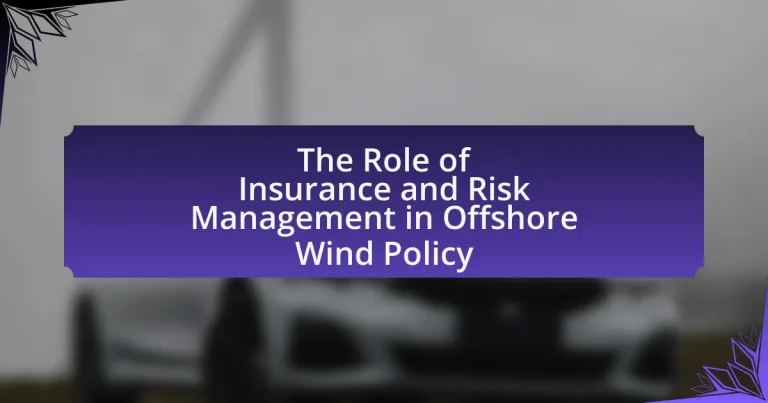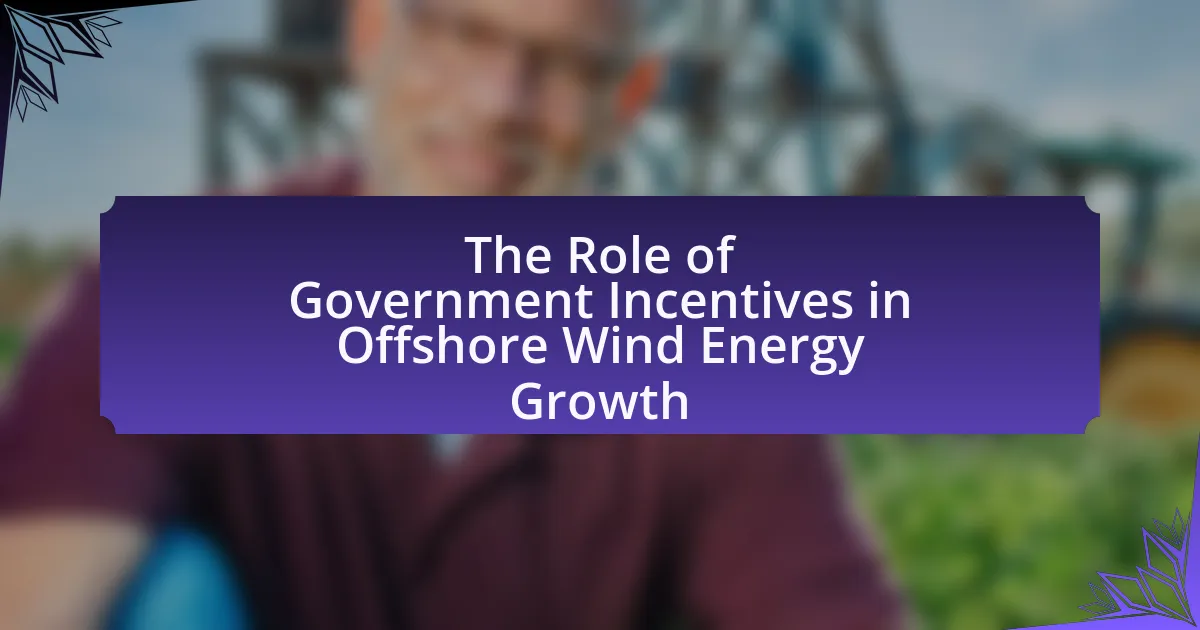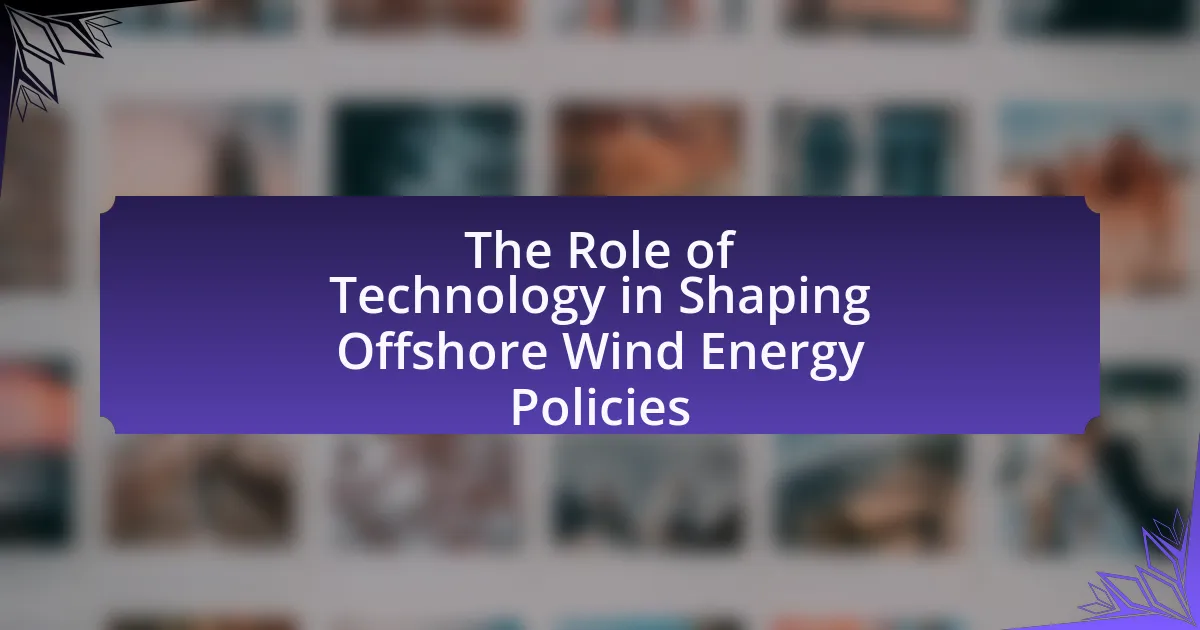The article examines the critical role of insurance and risk management in offshore wind policy, highlighting how these mechanisms provide financial protection and mitigate potential losses during the development and operation of offshore wind farms. It discusses various types of risks associated with offshore wind projects, including environmental, technical, financial, and regulatory risks, and explains how specialized insurance products, such as construction and operational insurance, help manage these risks. The article also emphasizes the importance of effective risk management strategies and stakeholder engagement in enhancing project viability and attracting investment, while outlining future trends and emerging risks that stakeholders should consider in the evolving offshore wind landscape.
What is the Role of Insurance and Risk Management in Offshore Wind Policy?
Insurance and risk management play a critical role in offshore wind policy by providing financial protection and mitigating potential losses associated with the development and operation of offshore wind farms. These mechanisms help to attract investment by reducing the perceived risks, such as equipment failure, natural disasters, and regulatory changes, which can significantly impact project viability. For instance, the Global Wind Energy Council reported that the offshore wind sector requires substantial capital investment, often exceeding billions of dollars, making effective risk management essential for securing funding and ensuring project success. Additionally, insurance products tailored for offshore wind projects, such as construction all-risk insurance and operational insurance, are vital in covering liabilities and ensuring compliance with regulatory requirements, thereby fostering a stable investment environment.
How do insurance and risk management contribute to the development of offshore wind projects?
Insurance and risk management are critical to the development of offshore wind projects by providing financial protection and facilitating investment. These mechanisms help mitigate the inherent risks associated with offshore wind, such as construction delays, equipment failure, and environmental challenges. For instance, specialized insurance products like construction all-risk insurance and operational insurance cover potential losses during the project lifecycle, thereby attracting investors who might otherwise be deterred by high-risk factors. Furthermore, effective risk management strategies, including thorough risk assessments and contingency planning, enhance project viability and stakeholder confidence, leading to a more favorable investment climate. This is evidenced by the increasing number of offshore wind projects being financed globally, with the global offshore wind market expected to reach over $100 billion by 2025, highlighting the importance of these financial instruments in supporting sustainable energy initiatives.
What types of risks are associated with offshore wind projects?
Offshore wind projects are associated with several types of risks, including environmental, technical, financial, and regulatory risks. Environmental risks involve adverse weather conditions and marine wildlife impacts, which can affect project viability and operational efficiency. Technical risks pertain to equipment failure, installation challenges, and maintenance issues, which can lead to increased costs and project delays. Financial risks include fluctuations in energy prices and investment uncertainties, impacting the project’s profitability. Regulatory risks arise from changes in government policies, permitting processes, and compliance requirements, which can hinder project development and operation. These risks necessitate comprehensive risk management strategies to ensure the successful implementation and sustainability of offshore wind projects.
How does insurance mitigate these risks?
Insurance mitigates risks in offshore wind policy by providing financial protection against potential losses. It enables project developers to transfer the financial burden of unforeseen events, such as equipment failure, natural disasters, or liability claims, to the insurer. This risk transfer encourages investment in offshore wind projects by ensuring that stakeholders can recover from significant financial setbacks. For instance, according to the Global Wind Energy Council, insurance coverage can help secure financing by demonstrating to investors that risks are managed effectively, thereby facilitating the growth of the offshore wind sector.
Why is insurance essential for stakeholders in offshore wind energy?
Insurance is essential for stakeholders in offshore wind energy because it mitigates financial risks associated with project development, operational challenges, and environmental uncertainties. Stakeholders, including investors, developers, and operators, face significant risks such as equipment failure, natural disasters, and regulatory changes that can lead to substantial financial losses. For instance, the Global Wind Energy Council reported that the average cost of offshore wind projects can exceed $4 billion, making risk management through insurance critical to protect investments and ensure project viability. By providing coverage for liabilities and damages, insurance enables stakeholders to secure financing, comply with regulatory requirements, and foster confidence in the long-term sustainability of offshore wind initiatives.
Who are the key stakeholders that benefit from insurance in offshore wind?
The key stakeholders that benefit from insurance in offshore wind include project developers, investors, insurers, and local communities. Project developers rely on insurance to mitigate financial risks associated with construction and operational phases, ensuring project viability. Investors benefit from reduced risk exposure, which enhances the attractiveness of offshore wind projects as investment opportunities. Insurers gain from underwriting policies that cover various risks, thus expanding their market presence. Local communities benefit indirectly through job creation and economic development resulting from insured offshore wind projects, which contribute to sustainable energy goals.
What are the financial implications of insurance for these stakeholders?
Insurance has significant financial implications for stakeholders in offshore wind policy, including developers, investors, and insurers. For developers, insurance mitigates financial risks associated with project delays, equipment failures, and liability claims, thereby stabilizing cash flow and facilitating project financing. Investors benefit from reduced risk exposure, as comprehensive insurance coverage can enhance the attractiveness of projects, leading to potentially higher returns. Insurers, on the other hand, face the challenge of accurately assessing risks in offshore wind projects, which can lead to higher premiums or potential losses if risks are underestimated. The financial dynamics among these stakeholders are influenced by the need for effective risk management strategies, as evidenced by the increasing demand for specialized insurance products tailored to the unique challenges of offshore wind energy, which has grown significantly in recent years.
What are the specific types of insurance relevant to offshore wind policy?
The specific types of insurance relevant to offshore wind policy include construction insurance, operational insurance, and liability insurance. Construction insurance covers risks associated with the building phase of offshore wind farms, protecting against damages and delays. Operational insurance provides coverage for the ongoing functioning of wind farms, addressing risks such as equipment failure and business interruption. Liability insurance protects against claims arising from accidents or damages caused by the wind farm operations. These insurance types are essential for mitigating financial risks and ensuring the viability of offshore wind projects.
What types of insurance are commonly used in offshore wind projects?
The types of insurance commonly used in offshore wind projects include construction insurance, operational insurance, and liability insurance. Construction insurance protects against risks during the building phase, covering damages to the project and equipment. Operational insurance provides coverage for risks associated with the ongoing operation of the wind farm, including equipment failure and business interruption. Liability insurance safeguards against claims arising from third-party injuries or property damage related to the wind project. These insurance types are essential for managing the significant financial and operational risks inherent in offshore wind energy development.
How does construction insurance protect offshore wind investments?
Construction insurance protects offshore wind investments by providing financial coverage against risks associated with the construction phase, such as property damage, liability claims, and project delays. This type of insurance ensures that investors are safeguarded from potential losses due to unforeseen events like accidents, natural disasters, or equipment failures, which can significantly impact project timelines and budgets. For instance, according to the Global Wind Energy Council, the offshore wind sector has seen substantial investments, with global capacity reaching over 35 GW by 2020, highlighting the importance of risk mitigation strategies like construction insurance to secure these investments against financial uncertainties.
What role does liability insurance play in offshore wind operations?
Liability insurance plays a critical role in offshore wind operations by providing financial protection against claims arising from accidents, injuries, or damages related to the operation of wind farms. This type of insurance mitigates the financial risks associated with potential lawsuits or compensation claims, which can be substantial given the complex nature of offshore projects. For instance, the offshore wind sector is subject to various regulatory requirements and safety standards, making liability insurance essential for compliance and risk management. According to the Global Wind Energy Council, the offshore wind industry has seen significant growth, with investments exceeding $30 billion in 2020 alone, highlighting the importance of adequate insurance coverage to protect stakeholders involved in these large-scale projects.
How do regulatory frameworks influence insurance requirements in offshore wind?
Regulatory frameworks significantly influence insurance requirements in offshore wind by establishing the legal and operational standards that projects must meet. These frameworks dictate the minimum insurance coverage necessary to protect against risks such as environmental damage, equipment failure, and liability claims. For instance, the European Union’s Renewable Energy Directive outlines specific safety and environmental regulations that necessitate comprehensive insurance policies for offshore wind farms. Additionally, national regulations, like those from the U.S. Bureau of Ocean Energy Management, require operators to demonstrate financial responsibility through insurance to cover potential damages, thereby shaping the insurance landscape in the offshore wind sector.
What are the key regulations affecting insurance in offshore wind policy?
Key regulations affecting insurance in offshore wind policy include the Renewable Energy Directive, the Offshore Safety Directive, and various national insurance requirements. The Renewable Energy Directive establishes a framework for promoting renewable energy sources, which impacts insurance by necessitating coverage for renewable energy projects. The Offshore Safety Directive mandates safety measures for offshore operations, influencing insurance policies to cover potential liabilities and risks associated with offshore wind farms. Additionally, national regulations often require specific insurance provisions to protect against environmental damage and operational risks, ensuring compliance with local laws and standards.
How do these regulations impact risk management strategies?
Regulations significantly shape risk management strategies by establishing compliance requirements that organizations must adhere to, thereby influencing their operational frameworks. For instance, regulations in the offshore wind sector often mandate rigorous safety standards and environmental assessments, compelling companies to integrate these factors into their risk management processes. This integration leads to enhanced risk identification and mitigation practices, as firms must evaluate potential regulatory risks alongside operational risks. Furthermore, adherence to regulations can improve stakeholder confidence and reduce liability, as demonstrated by the European Union’s Renewable Energy Directive, which emphasizes sustainability and risk transparency in renewable energy projects.
How can effective risk management enhance offshore wind policy outcomes?
Effective risk management enhances offshore wind policy outcomes by identifying, assessing, and mitigating potential risks associated with offshore wind projects. This proactive approach leads to improved project viability, increased investor confidence, and better regulatory compliance. For instance, comprehensive risk assessments can reveal vulnerabilities in project design or environmental impacts, allowing for timely adjustments that align with policy goals. Furthermore, effective risk management can lower insurance costs and attract funding by demonstrating a commitment to minimizing uncertainties, as evidenced by studies showing that projects with robust risk management frameworks experience fewer delays and cost overruns.
What best practices in risk management can be applied to offshore wind projects?
Best practices in risk management for offshore wind projects include comprehensive risk assessment, stakeholder engagement, and robust insurance coverage. Comprehensive risk assessment involves identifying potential risks such as environmental impacts, technical failures, and regulatory changes, allowing for proactive mitigation strategies. Stakeholder engagement ensures that all parties, including local communities and regulatory bodies, are informed and involved in the decision-making process, which can reduce opposition and enhance project acceptance. Robust insurance coverage protects against financial losses from unforeseen events, such as natural disasters or operational disruptions, ensuring project viability. These practices are supported by industry standards and guidelines, such as those from the Global Wind Energy Council, which emphasize the importance of risk management in achieving successful offshore wind project outcomes.
How can risk assessment tools improve decision-making in offshore wind?
Risk assessment tools can significantly enhance decision-making in offshore wind by providing data-driven insights that identify potential hazards and quantify their impacts. These tools analyze various risk factors, such as environmental conditions, technological failures, and financial uncertainties, enabling stakeholders to make informed choices regarding project feasibility, investment allocation, and operational strategies. For instance, a study by the International Renewable Energy Agency (IRENA) highlights that utilizing risk assessment frameworks can reduce project costs by up to 20% by optimizing resource allocation and minimizing unexpected delays. This evidence underscores the effectiveness of risk assessment tools in fostering safer and more economically viable offshore wind projects.
What role does stakeholder engagement play in effective risk management?
Stakeholder engagement is crucial for effective risk management as it facilitates the identification, assessment, and mitigation of risks through collaborative input. Engaging stakeholders, such as local communities, regulatory bodies, and industry experts, ensures diverse perspectives are considered, leading to more comprehensive risk assessments. For instance, a study by the International Renewable Energy Agency highlights that projects with active stakeholder involvement experience fewer delays and cost overruns, demonstrating that inclusive dialogue enhances project resilience. This collaborative approach not only improves risk management outcomes but also fosters trust and transparency, which are essential for the long-term success of offshore wind initiatives.
What are the future trends in insurance and risk management for offshore wind policy?
Future trends in insurance and risk management for offshore wind policy include the integration of advanced data analytics, increased focus on climate-related risks, and the development of tailored insurance products. Advanced data analytics will enhance risk assessment by utilizing real-time data from sensors and predictive modeling, allowing insurers to better understand and mitigate risks associated with offshore wind projects. The increasing frequency of extreme weather events due to climate change necessitates a stronger emphasis on climate-related risks, prompting insurers to adapt their policies and coverage options accordingly. Additionally, the emergence of specialized insurance products, such as parametric insurance, will provide more flexible and responsive coverage solutions that align with the unique challenges of offshore wind operations. These trends reflect the evolving landscape of offshore wind policy and the need for innovative risk management strategies to support sustainable energy development.
How is technology shaping the future of insurance in offshore wind?
Technology is significantly shaping the future of insurance in offshore wind by enhancing risk assessment and management capabilities. Advanced data analytics, including predictive modeling and machine learning, allow insurers to better evaluate the risks associated with offshore wind projects, leading to more accurate pricing and tailored coverage options. For instance, the integration of real-time monitoring systems and IoT devices enables continuous data collection on environmental conditions and equipment performance, which helps insurers identify potential risks early and adjust policies accordingly. This technological evolution not only improves the efficiency of underwriting processes but also fosters greater confidence among investors and stakeholders in the offshore wind sector, ultimately driving growth and innovation in renewable energy insurance solutions.
What emerging risks should be considered in future offshore wind policies?
Emerging risks that should be considered in future offshore wind policies include climate change impacts, technological failures, and supply chain vulnerabilities. Climate change can lead to more severe weather events, increasing the risk of damage to offshore installations. For instance, rising sea levels and intensified storms can affect the structural integrity and operational efficiency of wind farms. Technological failures, such as turbine malfunctions or cybersecurity threats, pose significant operational risks that can disrupt energy production. Additionally, supply chain vulnerabilities, highlighted during the COVID-19 pandemic, can lead to delays in equipment delivery and increased costs, impacting project timelines and financial viability. Addressing these risks through comprehensive insurance and risk management strategies is essential for the sustainable development of offshore wind energy.
What practical steps can stakeholders take to optimize insurance and risk management in offshore wind?
Stakeholders can optimize insurance and risk management in offshore wind by implementing comprehensive risk assessments, enhancing data collection and sharing, and fostering collaboration among industry participants. Comprehensive risk assessments allow stakeholders to identify potential hazards and quantify risks, which is essential for tailoring insurance products to specific project needs. Enhanced data collection and sharing improve the accuracy of risk models, enabling better pricing and coverage options. Collaboration among industry participants, including insurers, developers, and regulators, facilitates the development of standardized practices and policies, ultimately leading to more effective risk management strategies. These steps are supported by the increasing complexity and scale of offshore wind projects, which necessitate a proactive approach to risk management and insurance solutions.




